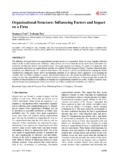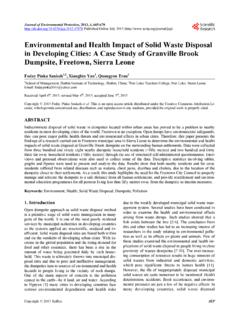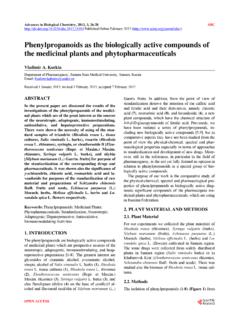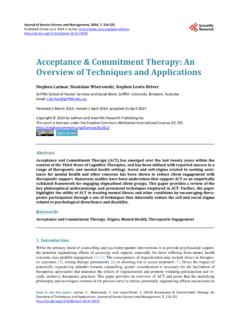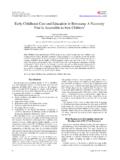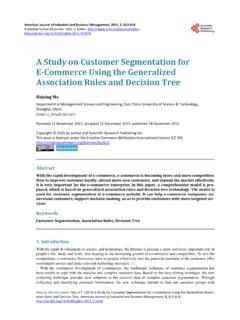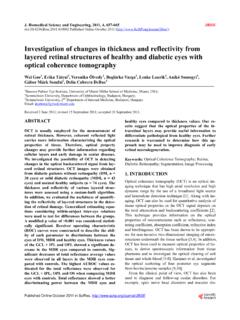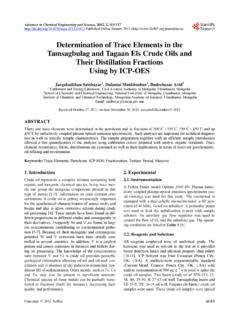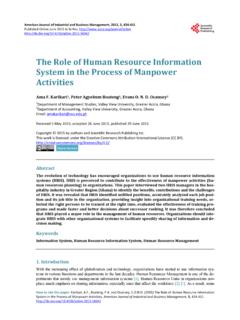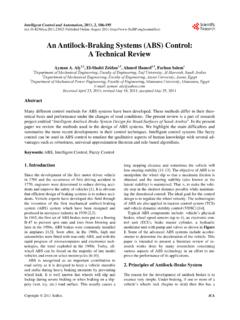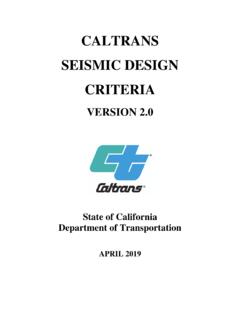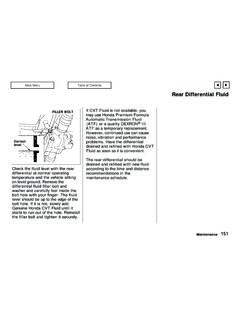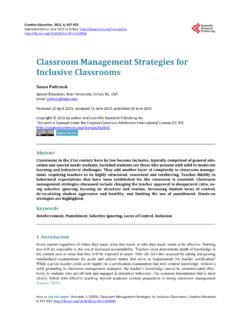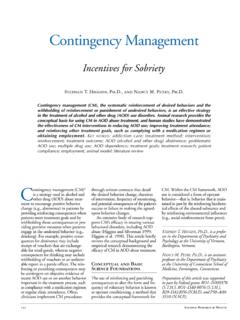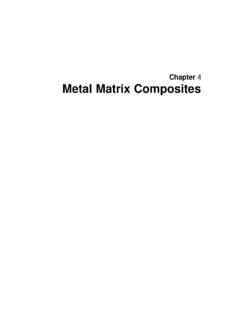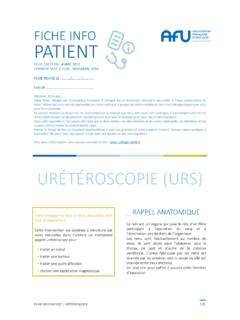Transcription of The impact of Positive Reinforcement on Employees ...
1 American Journal of Industrial and Business Management, 2014, 4, 9-12 Published Online January 2014 ( ) OPEN ACCESS AJIBM 9 The impact of Positive Reinforcement on Employees Performance in Organizations Leong Teen Wei, Rashad Yazdanifard Center for Southern New Hampshire University Programs, HELP College of Arts and Technology, Kuala Lumpur, Malaysia. Email: Received June 15th, 2013; revised July 15th, 2013; accepted July 22nd, 2014 Copyright 2014 Leong Teen Wei, Rashad Yazdanifard. This is an open access article distributed under the Creative Commons Attribution License, which permits unrestricted use, distribution, and reproduction in any medium, provided the original work is properly cited.
2 In accordance of the Creative Commons Attribution License all Copyrights 2014 are reserved for SCIRP and the owner of the intellectual property Leong Teen Wei, Rashad Yazdanifard. All Copyright 2014 are guarded by law and by SCIRP as a guardian. ABSTRACT Each employee s performance is important in an organization. A way to motivate it is through the application of Reinforcement theory which is developed by B. F. Skinner. One of the most commonly used methods is Positive Reinforcement in which one s behavior is strengthened or increased based on consequences. This paper aims to review the impact of Positive Reinforcement on the performances of Employees in organizations. It can be applied by utilizing extrinsic reward or intrinsic reward.
3 Extrinsic rewards include salary, bonus and fringe benefit while intrinsic rewards are praise, encouragement and empowerment. By applying Positive Reinforcement in these factors, desired Positive behaviors are encouraged and negative behaviors are eliminated. Financial and non-financial incentives have a Positive relationship with the efficiency and effectiveness of staffs. KEYWORDS Positive Reinforcement ; Employees Performance; Motivation 1. Introduction Over the years, managers are more concerned on em-ployees performances in terms of productivity and effi-ciency. It is very important as it affects an organization as a whole. One of the ways to provide motivation is through the application of Reinforcement theory.
4 B. F. Skinner introduced the Reinforcement theory, also known as learning theory. It refers to the stimuli used to produce desired behaviors with different occurrences and sched-ules [1]. This paper aims to examine the productivity of Employees as a result of the implementation of rein- forcement theory, specifically in Positive Reinforcement . 2. Positive Reinforcement Positive Reinforcement is a technique to elicit and to strengthen new behaviors by adding rewards and incen-tives instead of eliminating benefits [2]. It can be applied in workplace through fringe benefit, promotion chances and pay. Rewards can be classified into two categories which are intrinsic and extrinsic.
5 Intrinsic reward refers to something intangible such as praise and acknowl-edgement while extrinsic reward is salary, promotion, freedom in office and job security. Both types of rewards are closely associated with staffs accomplishments with- in an organization [3,4]. 3. Extrinsic Reward One of the basic motivations for Employees to work is salary. Linz and Semykina [5] revealed that personal in- come is positively correlated to job satisfaction. A study of Taiwan R&D professionals in technology sector found out that monetary incentives based on output has a posi-tive relationship with their work performance. Besides, the monitoring cost is reduced and it became more com-petitive among the staffs [6].
6 According to Liu [7], Hua- wei, a Chinese information technology company offers a high basic salary and the amount is still going up every year. In comparison to other new undergraduates and graduates, Huawei pays at least RMB 4000 higher than the average rate. Huawei s reward strategy to their em-The impact of Positive Reinforcement on Employees Performance in Organizations OPEN ACCESS AJIBM 10 ployees greatly increased the organization s productivity. On the other hand, engineers in Huawei earns from $ 6600 to $ 22,000 annually, depending on their per-formance.
7 The performance based technique can greatly increase the attentiveness and alertness of staffs [8]. The United States Postal Service (USPS) executed the pay-for-performance since 1995 and it made a significant impact to the organizations. The program counterbal-anced the consistent net loss for the past 24 years which summed up to ten billion dollars. With the implementa-tion of the program, the USPS not only improved drasti-cally in financials, but in delivery punctuality, workplace safety and also efficiency [9]. When a portion of wages are reliant on performance, Employees tend to work harder. However, it may lead to a vast impact to some of them because they stopped performing when pay was only reliant on their attendances in work [10].
8 Fringe benefit is also another instrument used in rein-forcing staffs. In the year 2013, Google, Inc. ranked first in Fortune as the best company to work for. Google is well-known for its benefits for the Employees . Google offers a variety of benefits such as complimentary food from cafeteria, childcare feature, healthcare, laundry ser-vices, shuttle bus, sports facilities, and a lot of holidays and even lessons for foreign languages [11]. When em-ployees are rewarded for their performances, they will most likely to increase the behavior and perform better. Therefore, monetary or extrinsic rewards reinforced em-ployees work behavior positively [12].
9 4. Intrinsic Reward Another type of Positive Reinforcement is intrinsic reward. It involves something other than financial motivation. It can be mere praise, delegation, empowerment or ac-knowledgement, but it has an impact on employee s per-formance in a Positive way [13,14]. When Employees obtain acknowledgement from managers or supervisors as a result of their job well done, they will feel appreci-ated and have a sense of belonging to the company [15]. This is highly valued by staffs and it is very likely that they will strive to perform better [3]. In The Carrot Principle findings, it was shown that 65 percent of respondents did not receive any forms of recognition and 79 percent reported that the lack of ap-preciation is the main reason for quitting the organization.
10 Those Employees of highest enthusiasm, re-sponded that managers have recognized their competence. It showed a significant need for staffs to be recognized in order for them to be more effective in their performances. Organizations that successfully identify the brilliance have a propensity to be more lucrative and it is reported that they can gain more than three times of return [16]. More than that, Wynter-Palmer and Jennifer [17] stated that empowerment or a sense of authority given to Employees is used to reinforce own capability and also enhance decision making skills at work. A study con-ducted in Golestan Telecommunication Company located in Iran showed that empowerment significantly improved the work performance [18].
